|
From The Developing Economist VOL. 3 NO. 1 An Econometric Analysis of the Major Choice of First-Generation College Students
By Sam Trejo
The Developing Economist
2016, Vol. 3 No. 1 | pg. 2/2 | «
I find that first-generation status has a statistically and economically significant effect on college major selection. This effect is independent of the compositional differences of firstgeneration students, including sex, AFQT score, family income, and race (which also all have a statistically significant effect on college major selection). Table 6 contains the results from a joint significance test across all equations for each variable in my multinomial logit model14.
Using the results from my multinomial logit model, I isolate the effect of being a first-generation college student on the probability of selecting a particular of major by calculating the average marginal effect of the FG COLLEGE variable. These impacts are displayed in table 7.
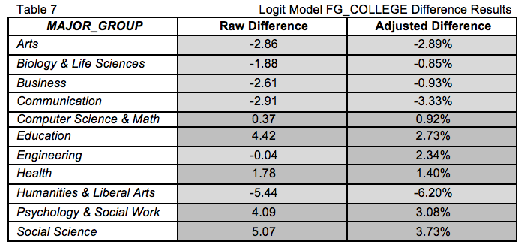
Table 7
Next, I construct scatter plots to examine the relationship between the propensity of first-generation students to select a given major group and characteristics of that major group. The vertical axis measures the excess likelihood that a firstgeneration student selects the major group compared to an otherwise identical student. The horizontal axis measures a particular descriptive statistic of the major group, taken from the ACS. Figures 1 & 2 display scatter plots using the major group's occupational concentration and average wage, respectively. In both cases, simple OLS regressions using the 11 major groups have positive slopes, with the slope in Figure 1 being .26 and the slope in Figure 2 being .40. This suggests that as occupational concentration and expected wages of a major group increase, so does the excess likelihood that first-generation college students select that major relative to otherwise identical non-first generation students.
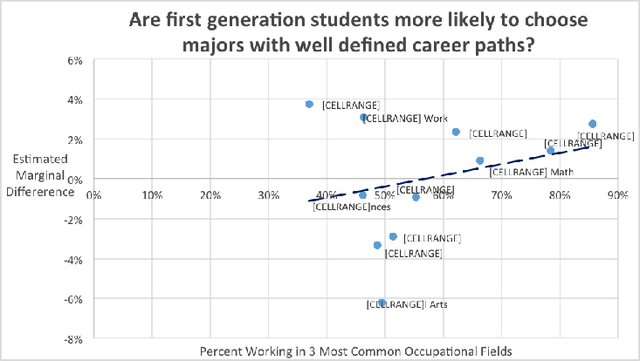
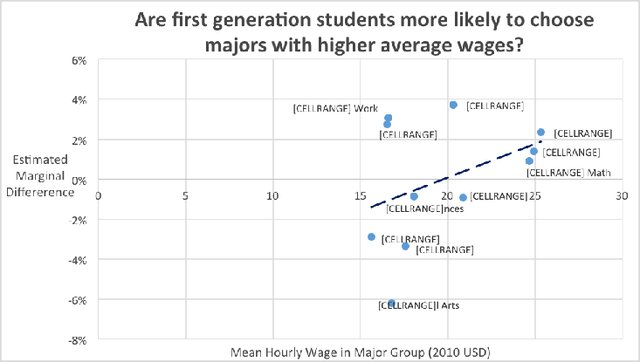
Figure 3 displays a final scatter plot for major group unemployment rates. A simple OLS regression using the 11 major fields has a negative slope with a coefficient of -.39. This suggests that as the unemployment rate for graduates of a major field increases, the likelihood that first-generation college students select that major compared to otherwise identical nonfirst-generation students decreases.
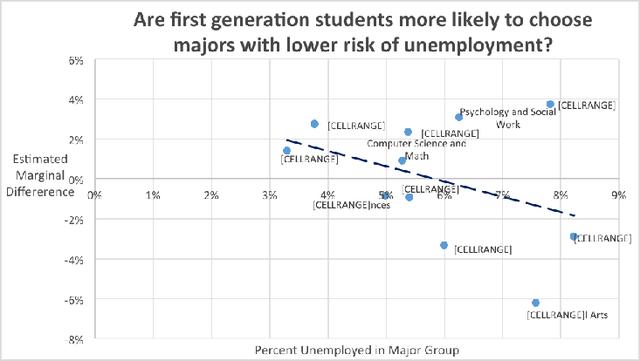
My results highlight how a simple comparison between the college majors selected by first-generation students compared to non-first-generation students can be misleading. For example, a native inspection of the raw data would suggest that first-generation students are actually slightly less likely than non-first-generation's students to become engineering majors. However, when I control for the systematic differences in race, ability, family income, and gender between the two groups, it becomes clear that engineering is actually among the specializations which first-generation students prefer most relative to their non-first-generation counterparts.
The multinomial logit model that I estimate not only confirms Saks and Shore's (2005) findings on the effect of family income on a student's college major decision, but also shows that not having parents who have attended college has a signi ficant effect on a student's college major selection. Though an individual's lifetime socioeconomic status is likely partially captured in any variable measuring parental education levels, that first-generation status had an effect even alongside the family income variable suggests that first-generation status may represent an independent effect and mechanism15. Perhaps unsurprisingly, in addition to first-generation status, family income, ability, race, and gender all appear to be signi ficantly related to an individual's college major selection.
According to my multinomial logit model, compared to non-first-generation students, first-generation students prefer the following majors: Computer Science & Math, Education, Engineering, Health, Psychology & Social Work, and Social Science. These same students are less drawn towards the following majors: Arts, Biology & Life Sciences, Business, Communication, and Humanities & Liberal Arts. The majors groups that first-generation students prefer tended to have low unemployment, high average wages, and a high occupational concentration. The existence of a preference among first-generation college students towards majors groups with these characteristics is consistent with my theoretical framework. Lacking information on intangible benefits to education, these students emphasize labor market rewards when selecting their field of study.
That occupational concentration appears to be related to first-generation student major preferences is particularly interesting. Unlike unemployment rates and average wages, occupational concentration is not directly linked to any economic returns to a college major. In fact, many major groups on both the high and low ends of average wages have similar occupational concentration scores (for example, education and health). Instead, occupational concentration is linked to the clarity of career path post-graduation. That first-generation students, who are likely forced to answer the "Why college?" question more frequently than non-first-generations students, tend to select fields with clear career paths is an important finding.
Unfortunately, data limitations prevented me from attempting to model the joint impact of these major group characteristics. Because the many qualities and expectations of a major simultaneously contribute to its desirability, further research should focus on better understanding the combined effects of these characteristics on the major selection decisions of different groups of students. Additionally, future research should investigate the consequences of having certain disadvantaged and underrepresented groups concentrated in particular major fields. For example, liberal arts programs like Plan II Honors that are interested in having a diverse student body might struggle to seem attractive to low-income and first-generation students. Additionally, universities seeking a diverse faculty may find their supply limited by the practical, more job market oriented focus of the specializations preferred by these underrepresented students.
The educational decisions an individual makes can have a large impact on many aspects of their life. For example, the wide range of college majors an individual can select from have a correspondingly wide range of economic outcomes. The selection of a college major is a nuanced decision significantly in uenced by numerous factors, including ability, sex, race, income, and parental education.
The empirical analysis in this paper suggests that firstgeneration students, compared to otherwise identical students, are more likely to select major groups with strong labor market rewards and a clear career path. Importantly, these differences exist even after controlling for sex, race, ability, and family income. Given that first-generation students are disproportionately from low-income families, this behavior is likely to contribute to the reduction of economic inequality over the long run. However, that these students are inclined towards economically safer majors with clear career paths suggests that they might be more constrained in their decisions relative to other students. If students have idiosyncratic, major-specific abilities, working to reduce these "constraints" could allow more suitable specialization among certain low-income and first-generation students and improve economic efficiency.
What exactly causes these differences in major selection is unclear. It may be that first-generation students receive less exposure to information on the potential non-monetary rewards to a college education; or perhaps being the first in one's family to attend college places certain pressures on a student; or it could simply be that a characteristically-distinct subset of the population of those whose parents did not attend college decide to pursue higher education. The underlying mechanisms driving the findings of this paper present interesting questions for future research focusing on educational inequality.
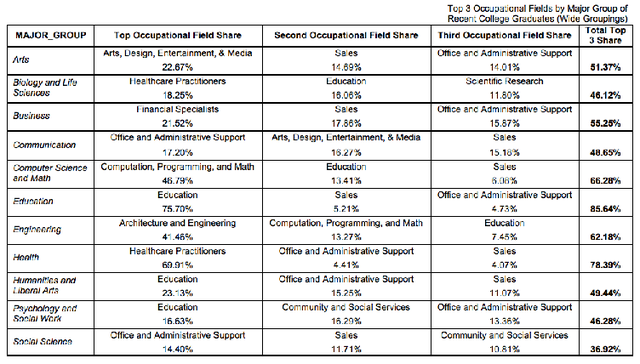
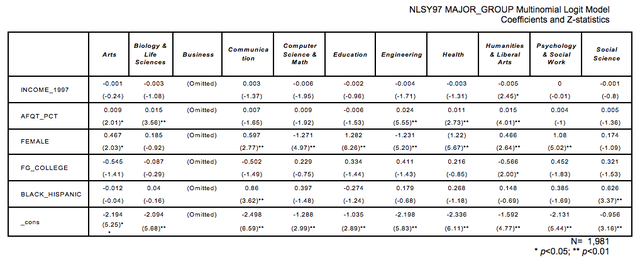
- Altonji, Joseph, Erica Blom, and Costas Meghir. "Heterogeneity in Human Capital Investments: High School Curriculum, College Major, and Careers." Annual Review of Economics 4 (2012): 185-223. Web.
- Black, Sandra, Kalena Cortes, and Jane Lincove. "You Have to Apply Yourself: Racial and Ethnic Differences in College Application." Working Paper (2014): Web. 1 Jan. 2015.
- Bureau of Labor Statistics, U.S. Department of Labor. National Longitudinal Survey of Youth 1997 cohort, 19972011 (rounds 1-15). Produced by the National Opinion Research Center, the University of Chicago and distributed by the Center for Human Resource Research, The Ohio State University. Columbus, OH. (8 February 2015).
- Carnevale, Anthony, and Ban Cheah. "From Hard Times to Better Times." Center on Education and the Workforce. Georgetown University, 05 Feb. 2015. Web. 06 Apr. 2015.
- Cabrera, A. F., & La Nasa, S. M. (2000). Overcoming the tasks on the path to college for America's disadvantaged. In A. Cabrera & S. La Nasa (Eds.), Understanding the college choice of disadvantaged students. New Directions for Institutional Research, No. 107, pp. 31-44. San Francisco: Jossey-Bass.
- "College Enrollment and Work Activity of 2014 High School Graduates." U.S. Bureau of Labor Statistics. U.S. Bureau of Labor Statistics, 16 Apr. 2015. Web. 26 Aug. 2015.
- Hoxby, Caroline, and Christopher Avery. "The Missing "One-Offs": The Hidden Supply of High-Achieving, Low Income Students." National Bureau of Economic Research (2012): Working Paper. Web.
- Montmarquette, Claude, Kathy Cannings, and Sophie Mahseredjian. "How Do Young People Choose College Majors?" Economics of Education Review 21.6 (2002): 543-56. Web.
- Saks, Raven E., and Stephen H. Shore. "Risk And Career Choice." B.E. Journal Of Economic Analysis & Policy: Advances In Economic Analysis & Policy 5.1 (2005): 1-45. Business Source Complete. Web. 20 Nov. 2015.
- Stage, F. K., Droogsma-Musoba, G., & Brown, C. (2002, April). Mathematics achievement: Racial-ethnicity and course taking patterns. American Educational Research Association, New Orleans.
- U.S. Census Bureau, U.S. Department of Commerce. American Community Survey, 2009-2011. <www.census.gov>; (7 September 2015).
† I cannot thank my advisor Dr. Gerald Oettinger and my second reader Dr. Robert Crosnoe enough for their mentorship and guidance. In addition, special thanks to Dr. Brian Duncan at The University of Colorado at Denver and Dr. Joseph Altonji at Yale University for methodological assistance.
- "College Enrollment and Work Activity of 2014 High School Graduates." U.S. Bureau of Labor Statistics. U.S. Bureau of Labor Statistics, 16 Apr. 2015. Web. 26 Aug. 2015.
- According to the same GCEW Report, the ratio of the median wage between workers with a college degree and workers with only a high school education has steadily increased from the mid-1970s to present day. College graduates now make over two times more than high school graduates.
- Carnevale, Anthony, and Ban Cheah. "From Hard Times to Better Times." Center on Education and the Workforce. Georgetown University, 05 Feb. 2015.
- Stage, F. K., Droogsma-Musoba, G., & Brown, C. (2002, April). Mathematics achievement: Racial-ethnicity and course taking patterns. American Educational Research Association, New Orleans.
- Cabrera, A. F., & La Nasa, S. M. (2000a). Overcoming the tasks on the path to college for America's disadvantaged. In A. Cabrera & S. La Nasa (Eds.), Understanding the college choice of disadvantaged students. New Directions for Institutional Research, No. 107, pp. 31-44. San Francisco: Jossey-Bass.
- Black, Sandra, Kalena Cortes, and Jane Lincove. "You Have to Apply Yourself: Racial and Ethnic Differences in College Application." Working Paper (2014). 1 Jan. 2015.
- Hoxby, Caroline, and Christopher Avery. "The Missing "One-Offs": The Hidden Supply of High-Achieving, Low Income Students." National Bureau of Economic Research (2012): Working Paper. Web.
- Saks, Raven E., and Stephen H. Shore. "Risk And Career Choice." B.E. Journal Of Economic Analysis & Policy: Advances In Economic Analysis & Policy 5.1 (2005): 1-45. Business Source Complete. Web. 20 Nov. 2015.
- Altonji, Joseph, Erica Blom, and Costas Meghir. "Heterogeneity in Human Capital Investments: High School Curriculum, College Major, and Careers." Annual Review of Economics 4 (2012): 185-223. Web.
- The NLSY97 survey is sponsored and directed by the U.S. Bureau of Labor Statistics and conducted by the National Opinion Research Center at the University of Chicago, with assistance from the Center for Human Resource Research at The Ohio State University.
- As a check for robustness, I also conducted the same analysis with all observations in the ACS sample. Changing the age did not significantly alter the results.
- The ACS has both broad and narrow occupational concentration groupings available. I chose to use the broad groupings, but as a check for robustness I also conducted the same analyses using the narrow groupings, which yielded very similar results.
- I use the "U.S. City Averages" Consumer Price Index from the Bureau of Labor and Statistic from the years 2009, 2010, and 2011 to perform these calculations.
- A full table of results from the multinomial logit model can be found in the data appendix at the end of this paper.
- Variables of FG COLLEGE interacted with the other 4 explanatory variables failed statistical significance tests, suggesting that this first generation effect may not vary systematically with to income, race, sex, and ability.
- Altonji, Joseph, Erica Blom, and Costas Meghir. "Heterogeneity in Human Capital Investments: High School Curriculum, College Major, and Careers." Annual Review of Economics 4 (2012): 185-223. Web.
- Black, Sandra, Kalena Cortes, and Jane Lincove. "You Have to Apply Yourself: Racial and Ethnic Differences in College Application." Working Paper (2014): Web. 1 Jan. 2015.
- Bureau of Labor Statistics, U.S. Department of Labor. National Longitudinal Survey of Youth 1997 cohort, 19972011 (rounds 1-15). Produced by the National Opinion Research Center, the University of Chicago and distributed by the Center for Human Resource Research, The Ohio State University. Columbus, OH. (8 February 2015).
- Carnevale, Anthony, and Ban Cheah. "From Hard Times to Better Times." Center on Education and the Workforce. Georgetown University, 05 Feb. 2015. Web. 06 Apr. 2015.
- Cabrera, A. F., & La Nasa, S. M. (2000). Overcoming the tasks on the path to college for America's disadvantaged. In A. Cabrera & S. La Nasa (Eds.), Understanding the college choice of disadvantaged students. New Directions for Institutional Research, No. 107, pp. 31-44. San Francisco: Jossey-Bass.
- "College Enrollment and Work Activity of 2014 High School Graduates." U.S. Bureau of Labor Statistics. U.S. Bureau of Labor Statistics, 16 Apr. 2015. Web. 26 Aug. 2015.
- Hoxby, Caroline, and Christopher Avery. "The Missing "One-Offs": The Hidden Supply of High-Achieving, Low Income Students." National Bureau of Economic Research (2012): Working Paper. Web.
- Montmarquette, Claude, Kathy Cannings, and Sophie Mahseredjian. "How Do Young People Choose College Majors?" Economics of Education Review 21.6 (2002): 543-56. Web.
- Saks, Raven E., and Stephen H. Shore. "Risk And Career Choice." B.E. Journal Of Economic Analysis & Policy: Advances In Economic Analysis & Policy 5.1 (2005): 1-45. Business Source Complete. Web. 20 Nov. 2015.
- Stage, F. K., Droogsma-Musoba, G., & Brown, C. (2002, April). Mathematics achievement: Racial-ethnicity and course taking patterns. American Educational Research Association, New Orleans.
- U.S. Census Bureau, U.S. Department of Commerce. American Community Survey, 2009-2011. <www.census.gov>; (7 September 2015).
Endnotes
† I cannot thank my advisor Dr. Gerald Oettinger and my second reader Dr. Robert Crosnoe enough for their mentorship and guidance. In addition, special thanks to Dr. Brian Duncan at The University of Colorado at Denver and Dr. Joseph Altonji at Yale University for methodological assistance.
- "College Enrollment and Work Activity of 2014 High School Graduates." U.S. Bureau of Labor Statistics. U.S. Bureau of Labor Statistics, 16 Apr. 2015. Web. 26 Aug. 2015.
- According to the same GCEW Report, the ratio of the median wage between workers with a college degree and workers with only a high school education has steadily increased from the mid-1970s to present day. College graduates now make over two times more than high school graduates.
- Carnevale, Anthony, and Ban Cheah. "From Hard Times to Better Times." Center on Education and the Workforce. Georgetown University, 05 Feb. 2015.
- Stage, F. K., Droogsma-Musoba, G., & Brown, C. (2002, April). Mathematics achievement: Racial-ethnicity and course taking patterns. American Educational Research Association, New Orleans.
- Cabrera, A. F., & La Nasa, S. M. (2000a). Overcoming the tasks on the path to college for America's disadvantaged. In A. Cabrera & S. La Nasa (Eds.), Understanding the college choice of disadvantaged students. New Directions for Institutional Research, No. 107, pp. 31-44. San Francisco: Jossey-Bass.
- Black, Sandra, Kalena Cortes, and Jane Lincove. "You Have to Apply Yourself: Racial and Ethnic Differences in College Application." Working Paper (2014). 1 Jan. 2015.
- Hoxby, Caroline, and Christopher Avery. "The Missing "One-Offs": The Hidden Supply of High-Achieving, Low Income Students." National Bureau of Economic Research (2012): Working Paper. Web.
- Saks, Raven E., and Stephen H. Shore. "Risk And Career Choice." B.E. Journal Of Economic Analysis & Policy: Advances In Economic Analysis & Policy 5.1 (2005): 1-45. Business Source Complete. Web. 20 Nov. 2015.
- Altonji, Joseph, Erica Blom, and Costas Meghir. "Heterogeneity in Human Capital Investments: High School Curriculum, College Major, and Careers." Annual Review of Economics 4 (2012): 185-223. Web.
- The NLSY97 survey is sponsored and directed by the U.S. Bureau of Labor Statistics and conducted by the National Opinion Research Center at the University of Chicago, with assistance from the Center for Human Resource Research at The Ohio State University.
- As a check for robustness, I also conducted the same analysis with all observations in the ACS sample. Changing the age did not significantly alter the results.
- The ACS has both broad and narrow occupational concentration groupings available. I chose to use the broad groupings, but as a check for robustness I also conducted the same analyses using the narrow groupings, which yielded very similar results.
- I use the "U.S. City Averages" Consumer Price Index from the Bureau of Labor and Statistic from the years 2009, 2010, and 2011 to perform these calculations.
- A full table of results from the multinomial logit model can be found in the data appendix at the end of this paper.
- Variables of FG COLLEGE interacted with the other 4 explanatory variables failed statistical significance tests, suggesting that this first generation effect may not vary systematically with to income, race, sex, and ability.
Suggested Reading from Inquiries Journal
Senate Bill 1720 took effect in the state of Florida in 2014. This new education policy makes college placement tests and remedial courses voluntary for many students preparing to enter college, with the aim of providing... MORE»
Nontraditional students represent a substantial proportion of those enrolled in higher education institutions. The purpose of this literature review is to identify (1) distinctions between traditional and nontraditional students and (2) factors that impact retention among nontraditional students. Age, selection of major among females... MORE»
Colorism or skin tone bias is a form of discrimination based on skin tone that typically awards advantages to light-skinned people while penalizing dark-skinned people within an ethnic group. There is very little research on colorism in higher education, so this study aims to shed light on an under-studied aspect of Black undergraduate... MORE»
The process of selecting a dissertation adviser can be accomplished in a number of ways. The importance, however, of this process should not be understated. This relationship between adviser and advisee often can be the difference between completing or not completing the dissertation. This research study looked at the selection... MORE»
Latest in Economics
2020, Vol. 12 No. 09
Recent work with the Economic Complexity Index (ECI) has shown that a country’s productive structure constrains its level of economic growth and income inequality. Building on previous research that identified an increasing gap between Latin... Read Article »
2018, Vol. 10 No. 10
The value proposition in the commercial setting is the functional relationship of quality and price. It is held to be a utility maximizing function of the relationship between buyer and seller. Its proponents assert that translation of the value... Read Article »
2018, Vol. 10 No. 03
Devastated by an economic collapse at the end of the 20th century, Japan’s economy entered a decade long period of stagnation. Now, Japan has found stable leadership, but attempts at new economic growth have fallen through. A combination of... Read Article »
2014, Vol. 6 No. 10
In July 2012, Spain's unemployment rate was above 20%, its stock market was at its lowest point in a decade, and the government was borrowing at a rate of 7.6%. With domestic demand depleted and no sign of recovery in sight, President Mariano Rajoy... Read Article »
2017, Vol. 9 No. 10
During the periods of the Agrarian Revolt and the 1920s, farmers were unhappy with the economic conditions in which they found themselves. Both periods witnessed the ascent of political movements that endeavored to aid farmers in their economic... Read Article »
2017, Vol. 7 No. 2
In 2009, Brazil was in the path to become a superpower. Immune to the economic crises of 2008, the country's economy benefitted from the commodity boom, achieving a growth rate of 7.5 per cent in 2010, when Rousseff was elected. A few years later... Read Article »
2012, Vol. 2 No. 1
The research completed aimed to show that the idea of fair trade, using the example of goals for the chocolate industry of the Ivory Coast, can be described as an example of the economic ideal which Karl Marx imagined. By comparing specific topics... Read Article »
|



























